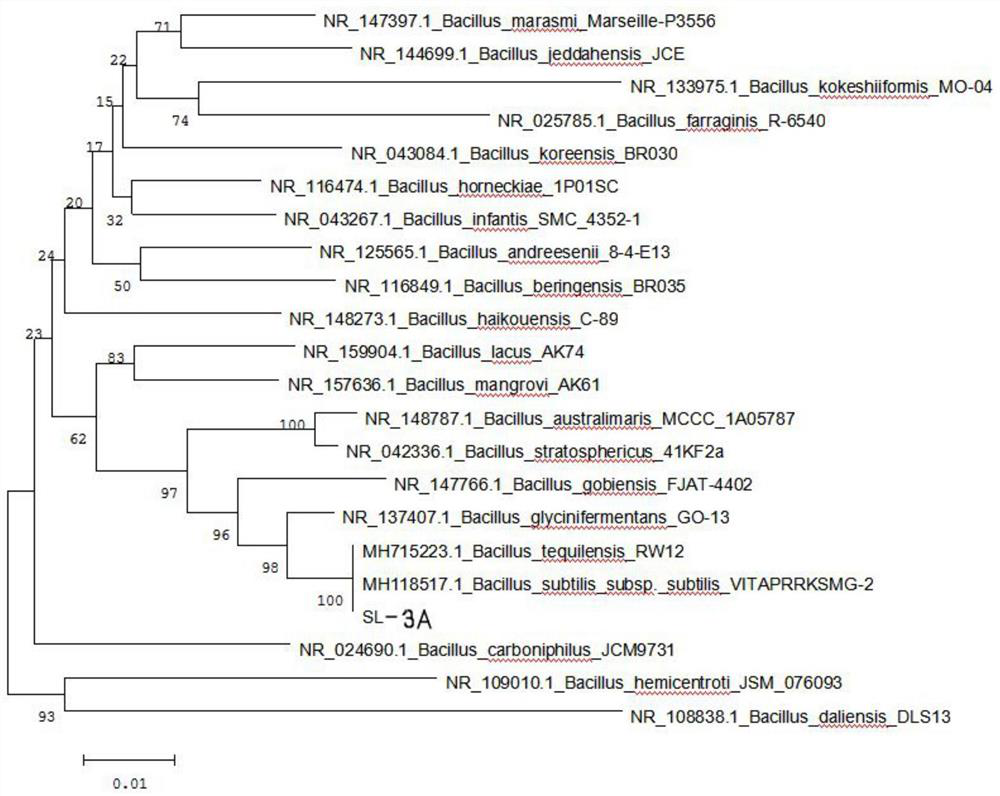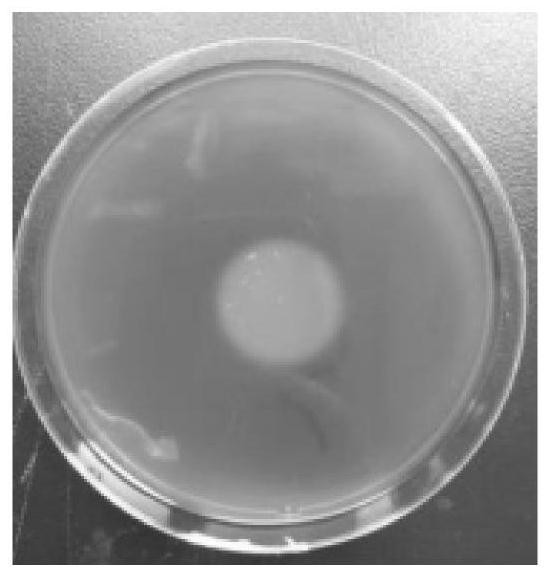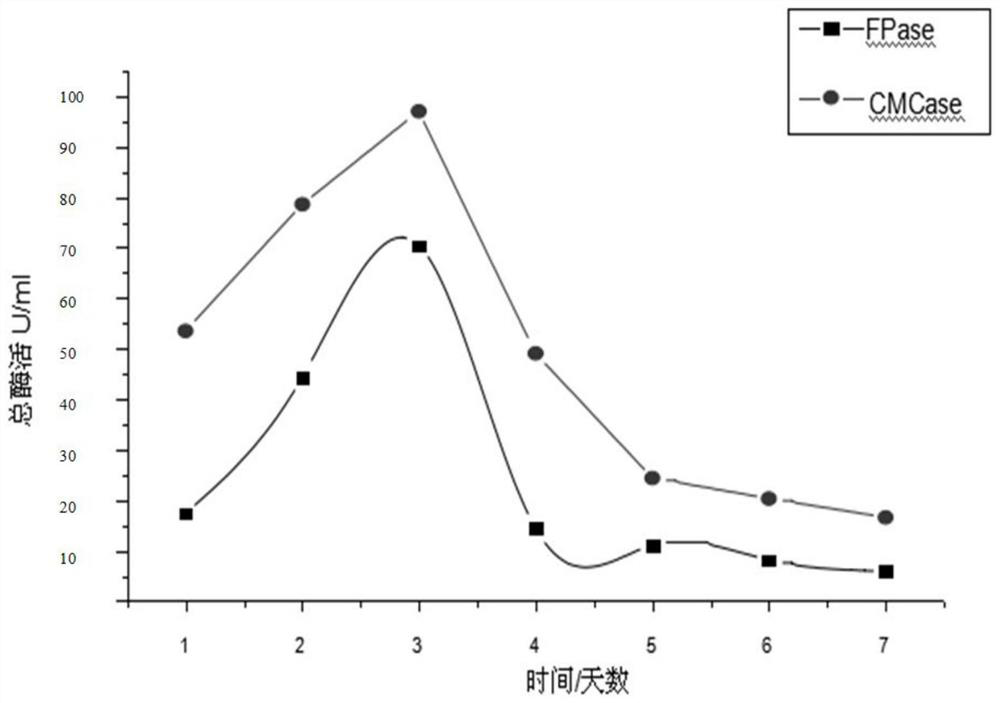A strain of Bacillus subtilis sl-3a, a tobacco stalk degrading bacterial agent and its preparation method and application
A technology of Bacillus subtilis and tobacco stalks, applied in the field of microorganisms, can solve the problems of bacterial pollution and inability to have strong cellulose degradation ability
- Summary
- Abstract
- Description
- Claims
- Application Information
AI Technical Summary
Problems solved by technology
Method used
Image
Examples
preparation example Construction
[0034] The present invention also provides a method for preparing the tobacco stalk-degrading bacterial agent described in the above technical solution, comprising the following steps: inoculating the Bacillus subtilis SL-3A in a sodium carboxymethylcellulose fermentation medium for 2-4 days of fermentation , to obtain the bacterial agent for degrading tobacco stalks. In the present invention, the sodium carboxymethylcellulose fermentation medium preferably uses peptone as the sole nitrogen source and sodium carboxymethylcellulose as the sole carbon source, and the C / N ratio of the sole carbon source to the sole nitrogen source is 2:1. In the present invention, the inoculum volume fraction of the Bacillus subtilis SL-3A is preferably 6-10%, more preferably 8%; the temperature of the fermentation culture is preferably 25-45°C, more preferably 37°C, pH The value is preferably 6.0-8.0, more preferably 7, and the fermentation culture further includes shaking, and the rotating spe...
Embodiment 1
[0038] Determination of the ability of SL-3A to degrade cellulose
[0039] 1.1 Experimental materials
[0040] 1.1 Test strains
[0041] The bacterial strain screened from tobacco stalk waste: SL-3A was used as the experimental material.
[0042] 1.2 Medium
[0043] (1) Common media for bacterial strain purification
[0044] LB medium, LB liquid medium;
[0045] (2) Degradation cellulase screening medium
[0046] Carboxymethylcellulose sodium medium (g / L): MgSO 4 ·7H 2 O 0.1, KH 2 PO 4 0.5, CaCl 2 0.1,K 2 HPO 4 2. Sodium carboxymethyl cellulose 10, (NH 4 ) 2 SO 4 2. Agar 18, pH 7.0-7.4;
[0047]Carboxymethyl cellulose enzyme activity (CMCase) detection medium (g / L): peptone 10, beef extract powder 10, sodium chloride 1.5, sodium carboxymethyl cellulose 10, KH 2 PO 4 1.0, MgSO 4 ·7H 2 O 0.3, pH 7.0;
[0048] Filter paper enzyme activity (FPase) detection medium (g / L): peptone 10, beef extract 10, sodium chloride 1.5, filter paper 0.05, KH 2 PO 4 1.0, ...
Embodiment 2
[0072] Study on the Growth-promoting Function of SL-3A Strain
[0073] In this example, the experiments of SL-3A dissolving phosphorus and potassium are studied.
[0074] 2.1 Materials
[0075] 2.1.1 Tested strains
[0076] Bacteria SL-3A was provided by the Microbiology Laboratory of Fuyang Normal University.
[0077] 2.1.2 Medium
[0078] (1) Common media for bacterial strain purification
[0079] LB medium, LB liquid medium;
[0080] (2) Determination medium for phosphorus solubilizing effect
[0081] Organophosphate solid medium (g / L): glucose 10g, (NH 4 ) 2 SO 4 0.5, NaCl 0.3, KCl 0.3, MgSO 4 ·7H 2 O 0.3, FeSO 4 ·7H 2 O 0.03, MnSO 4 4H 2 O 0.03, CaCO 3 5. Lecithin 2, agar 20, pH 7.0-7.5.
[0082] Organic phosphorus liquid medium (g / L): glucose 10g, (NH 4 ) 2 SO 4 0.5g, NaCl 0.3g, KCl 0.3g, MgSO 4 ·7H 2 O 0.3g, FeSO 4 ·7H 2 O 0.03g, MnSO 4 4H 2 O 0.03g, CaCO 3 5g, lecithin 2g, pH 7.0-7.5. (During the experiment, replace lecithin with fresh egg...
PUM
 Login to View More
Login to View More Abstract
Description
Claims
Application Information
 Login to View More
Login to View More - R&D
- Intellectual Property
- Life Sciences
- Materials
- Tech Scout
- Unparalleled Data Quality
- Higher Quality Content
- 60% Fewer Hallucinations
Browse by: Latest US Patents, China's latest patents, Technical Efficacy Thesaurus, Application Domain, Technology Topic, Popular Technical Reports.
© 2025 PatSnap. All rights reserved.Legal|Privacy policy|Modern Slavery Act Transparency Statement|Sitemap|About US| Contact US: help@patsnap.com



